Common Questions
Most Popular Questions
We are Located in Central Northern NC. We are only 30 Minutes from VA 90 minutes to Raleigh and 90 to Charlotte, in Winston Salem.

Kitten Prices
- Siamese Kittens – $1650
- Balinese (short hair) – $1650
- Balinese (long-hair) – $2050
All of Our Kittens Receive the Following Before Going to Their Permanent Homes:
4 in 1 Vaccinations against Panleukopeni, Rhinotracheitis, Calicivirus, & Chlamydia.
2 rounds of De-worming and Fecal Exam to ensure all kittens are free of internal parasites.
1 Year Genetic Health Guarantee against any congenital or hereditary defects.
72 Hour Health Guarantee with Activated Trupanion Coverage.
Revolution Flea and Tick Treatment to protect them for 30 days.
Our Kitten Care Package, which includes a week’s worth of Purina Pro Plan Premium Kitten Food, a bag of Pine Pellets non-clumping kitty litter, some fun toys we know our kittens enjoy and a small stuffed toy that will have the scent of their Mom and litter mates to help them adjust to their new home a little easier.
A Full 30 Days of free Pet Insurance through Trupanion.
Micro-Chipping with Microchip ID systems, “PRO-ID Mini” Micro-chips and unique identifier code.
And Most Importantly, You will receive A Healthy, Highly Socialized, Confident Kitten that is free of diseases, parasites and fleas.
Check our current waitlist information and the price of the kitten you would like to reserve to ensure the price point and estimated availability work for your family.
You can then proceed to our kitten contract, fill out the required information, and place the non-refundable required $550 deposit.
Kitten Contract and Deposit Link
You will automatically receive a confirmation email with more information. You will also receive an invitation to join our Private Facebook Group, which is different from our Public Facebook Page. This group is reserved only for those who have adopted a kitten through us or currently have a deposit placed with us. You will also be asked to fill out our Family Form to help us understand your family dynamics, in case you’d like some advice on the kitten personality that would best fit you and your family. This form is completely optional but helpful. If you don’t see the confirmation email, be sure to check your spam folder and, if you use Gmail, your promotions folder.
A member of our family will also be in touch to personally welcome you to the Siamese Sweetie Family.
If you have any additional questions, please feel free to contact us by email:
Or message us on our Facebook Page at:
Facebook Link
Yes! We do offer shipping within the United States. The complete cost generally comes to between $400-$500. This includes airfare, travel carrier, travel to the airport and a health certificate issued by a vet (required by most airlines). This does not include the price of the kitten.

Siamesesweeties@gmail.com
Double the Love: Discover the Charm
Siamese Sweeties
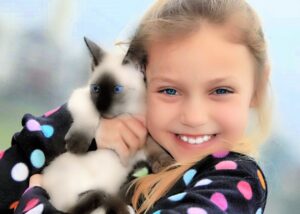
Traditional Siamese Kittens
Balinese Beauties
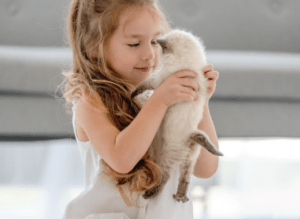
Babycake Balinese Babies
Browse Our Balinese Babies
 Balinese cats are a long-haired variation of the Siamese breed. They originated from a gene mutation that produced a long, soft, silky coat. Siamese breeders in the US discovered that they were occasionally seeing kittens that were puffier than a typical Siamese. They knew that no other breeds had been introduced into their breeding program, but every once in a while, these long-haired kittens would appear.
Balinese cats are a long-haired variation of the Siamese breed. They originated from a gene mutation that produced a long, soft, silky coat. Siamese breeders in the US discovered that they were occasionally seeing kittens that were puffier than a typical Siamese. They knew that no other breeds had been introduced into their breeding program, but every once in a while, these long-haired kittens would appear.
Although the beauty of these cats was recognized, these kittens were placed as pets rather than breeding or show animals, as they did not meet the standard breed descriptions. It wasn’t until 1928 that the first Balinese was registered, thanks to a few breeders who fell in love with this sweet, regal breed.
As Balinese cats are becoming increasingly popular, some people have tried to take advantage. There has been a lot of fraud concerning this breed lately. I have seen backyard breeders presenting Himalayan, Ragdoll, and Persian mixes as Balinese. They may look similar enough as kittens to fool those who are not highly educated on the breed, but they will likely trigger allergies and their true nature will become apparent as they grow. One thing to look for is that a Balinese will have a super soft, silky coat, comparable to Angora rabbit fur. You can definitely feel the difference between a Balinese coat and other cats’ fur. A Balinese will also always have a plumed tail and no undercoat. They do not require brushing, although they do enjoy it, and they will not develop mats in their fur like other long-haired breeds. True Balinese cats will not have mitted feet, also known as snowshoes. This is usually a Ragdoll trait, although it has slowly been making its way into the Siamese breed. As of now, it is not an accepted trait of the Balinese in any of the US Cat Associations. Balinese are also smaller cats, comparable in size to Siamese. They may look a bit larger than Siamese, but this is generally because of the fur. Female Balinese that are not overweight typically weigh around 6-8 lbs, while males can be about 3-5 lbs heavier. For comparison, Ragdolls are typically 15-20 lbs. One last thing to mention: I have seen fluffy Siamese kittens being passed off as Balinese. Traditional Siamese kittens do tend to have a bit of fluff as kittens but lose it as adults. A Balinese should have a noticeably fluffier appearance as a kitten, with a plumed tail, and as they age, they will lose some fluff but will always maintain a semi-long coat with a plumed tail.
 Many families gravitate toward Balinese cats due to their hypoallergenic properties. However, it’s essential to understand that “hypoallergenic” means “less allergenic,” not completely non-allergenic. Most allergies that are caused by cats are caused by a protein cats produce in their saliva called Fel d 1. Both Siamese and Balinese cats are known to produce less of this protein Balinese less than the Siamese.
Many families gravitate toward Balinese cats due to their hypoallergenic properties. However, it’s essential to understand that “hypoallergenic” means “less allergenic,” not completely non-allergenic. Most allergies that are caused by cats are caused by a protein cats produce in their saliva called Fel d 1. Both Siamese and Balinese cats are known to produce less of this protein Balinese less than the Siamese.
Balinese come in two different coat lengths, short hair and long hair, which turns more into a medium hair length when they hit adulthood. Short hair Balinese have a coat is shorter, but still silky smooth.
We actively test our cats for Fel d 1 levels and breed those who meet the breed standard and produce less Fel d 1.
We also feed our cats Purina Pro Plan LiveClear. The first food to lessen the allergies cats produce.
When cats are fed a diet with the egg product ingredient containing anti-Fel d 1 IgY, the levels of active Fel d 1 in their saliva were significantly reduced within 3 weeks. The diet with the egg product ingredient also significantly reduced active Fel d 1 on the cat’s hair: 97% of the cats had a decrease in active Fel d 1 levels, with an average reduction of 47% starting in Week 3.
One-half of the cats had at least a 50% reduction in active Fel d 1 levels on their hair, and 86% of cats had a reduction of at least 30% from baseline levels.
A reduction in active Fel d 1 in the cats’ saliva and on their hair will ultimately reduce active Fel d 1 in the environment, which helps reduce symptoms in allergic people.
This discovery is transforming how people manage allergies to cats, ultimately bringing cats and people closer together.
But..remember, even if they’re hypoallergenic, they’ll still steal your heart with their charming personalities
Siamese cats are not typically considered hypoallergenic. While they are known for their distinctive appearance and vocal personalities, they do produce allergenic proteins in their saliva, including Fel d 1, which can trigger allergies in some individuals. However, some people with cat allergies may find that they react less severely to Siamese cats compared to other breeds due to the lower levels of Fel d 1 they produce in comparison to some other breeds.
It’s important to note that there is no completely hypoallergenic cat breed, as all cats produce some level of allergenic proteins. If you or someone in your family has allergies and is considering getting a Siamese cat or any other breed, it’s a good idea to spend time around cats of that breed to see if there are any allergic reactions before bringing one into your home. Additionally, taking measures like regular grooming and cleaning can help reduce allergens in the environment.
Siamese and Balinese cats are closely related and share many similarities, but they also have some differences:
Coat Length:
- Siamese: Siamese cats have a short, sleek coat that lies close to their bodies. Their coat is fine and doesn’t have an undercoat.
- Balinese: Balinese cats, on the other hand, have long, flowing coats. Their fur is silky and tends to be medium in length. Unlike Siamese, Balinese cats do not have an undercoat, which makes their grooming needs somewhat different.
Coat Color and Pattern:
- Siamese: Siamese cats are known for their distinct color points. Their ears, face, paws, and tail are typically a darker color than the rest of their body. Common color points include seal, chocolate, blue, and lilac.
- Balinese: Balinese cats have the same color points as Siamese cats, but their longer fur gives them a softer, more flowing appearance.
Body Type:
- Siamese: Siamese cats have a slender and lithe body with a long neck, giving them an elegant appearance. They are known for their striking blue almond-shaped eyes and large ears.
- Balinese: Balinese cats share the same elegant body type as Siamese cats, characterized by a slim, elongated frame. They also have large ears and striking blue eyes.
Personality:
- Both Siamese and Balinese cats are renowned for their outgoing, vocal, and social personalities. They are highly interactive and often referred to as “people cats” because they enjoy being the center of attention and engaging with their human companions.
- They are affectionate and can be demanding of your time and attention. They enjoy playing and are known for their intelligence.
Allergenic Properties:
- Both Siamese and Balinese cats are considered to be among the cat breeds that produce lower levels of the allergenic protein Fel d 1, which may make them a better choice for individuals with allergies compared to some other breeds. However, they are not completely hypoallergenic.
In summary, the primary differences between Siamese and Balinese cats lie in their coat length and appearance, but their personalities and tendencies are quite similar. Balinese cats are essentially a long-haired variation of the Siamese breed, sharing many of the same characteristics.
Here Are Our Observations:
In our experience, we’ve noticed some general differences between male and female cats:
Male Cats:
- Male cats tend to be more affectionate and sociable with the entire family. They readily acknowledge multiple owners and actively seek attention from everyone.
- They have a penchant for cuddling and enjoy the warmth of a human companion by their side. They often exhibit playful and goofy behavior, providing consistent moments of laughter.
- Sometimes, male cats can be a bit clumsy and may require more attention and affection.
Female Cats:
- Female cats often exhibit intelligence and may form a stronger bond with a single owner. They show affection to and tolerate other family members but typically display the most loyalty and love towards one specific person.
- They tend to be more assertive and independent, occasionally exhibiting a bossy demeanor. However, they will seek out extra love when they desire it.
- Female cats often possess an elegant and graceful demeanor.
It’s essential to remember that each cat has its unique personality, which can override these gender-based observations. Both male and female cats can make wonderful pets; your choice may depend on your specific preferences. Additionally, it’s worth noting that spaying and neutering cats can help prevent spraying and reduce aggressive behavior.
Ultimately, the decision comes down to what you’re seeking in a feline companion. 🐾😺
All of our Sweeties are raised with our Bichon Frise Puppy. Most will bond easily with any type of dog within a week of going home.
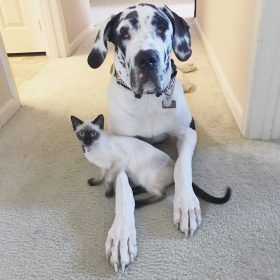
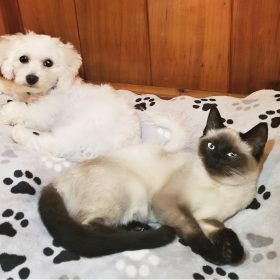
Siamese & Balinese kittens are born with a gene that produces partial albinism. A genetic mutation of this gene restricts coloring to the cat’s extremities, including the facial mask, legs, and tail. This mutation affects the enzymes that produce pigment in the fur, but the amount of pigment these enzymes produce is greatly affected by temperature.
Temperatures of 98 degrees Fahrenheit or greater cause the enzymes to produce almost no discernible coloring in the hair shafts on the cat’s main body. Since a cat’s extremities are generally cooler than the body, the enzymes produce coloring in these areas.
Combine this heat-sensitive enzymatic action with other modifying genes, and the results are the various color-point patterns seen in Siamese cats.
Siamese kittens are born pure white with pink noses. The temperature inside the womb exceeds 98 degrees Fahrenheit, so there is no color production. The enzymes don’t become fully operational until the kittens are a bit older. This means that although we can make an educated guess at the color outcome of a breeding, we won’t be able to tell which color a kitten will be until approximately a week or two after birth.
Blue eyes are also the norm for Siamese kittens. While many breeds are initially born with blue eyes that darken later on, the partial albinism gene found in the Siamese causes their eyes to remain blue. The color you see is actually the result of light being reflected back from the retina. This means the blue color you see can vary.
We currently offer Seal, Chocolate, Blue, Lilac, Flame, Torite & Lynx Point Siamese and Balinese
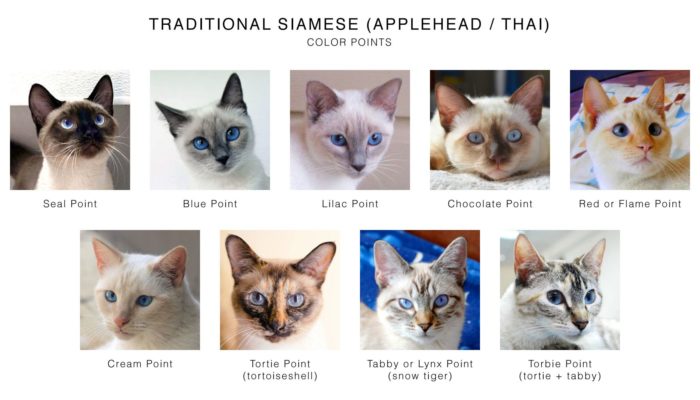
Seal Points will have fawn or cream-colored bodies with dark brown, almost black, color points on their face, ears, paws, and tail. Their paw pads and nose leather are also dark brown.
Chocolate Points will have ivory-colored bodies with milk chocolate color points on their face, ears, paws, and tail. Their nose leather and paw pads are cinnamon-pink.
Blue Points will have bluish-white or silvery-colored bodies with deep blue/gray color points on their face, ears, paws, and tail. Their nose and paw pads are slate blue-gray colored.
Lilac Points will have white bodies with pinkish-gray color points on their face, ears, paws, and tail. Their nose leather and paw pads are cinnamon-pink.
Flame Points (Red Points) will have warm white bodies with reddish-orange, almost golden, color points on their face, ears, paws, and tail. Their nose leather and paw pads are pinkish in color.
Tortie Points have parti-colored points and can be flecked with shades of red and cream. Because this pattern is a sex-linked mutation, Torties are always females. Their body color will depend on the variation of color point but can also appear speckled.
Tortie Points can come in these point colors:
- Seal-Tortie Point
- Chocolate-Tortie Point
- Blue-Tortie Point
- Lilac-Tortie Point
- Blue-Cream Point
- Lilac-Cream Point
Lynx Points are essentially a traditional Siamese cat with tabby markings primarily on the face, ears, legs, and tail. What you get is a Siamese with “eyeliner”—stripes around their eyes and on their legs, as well as the classic ‘M’ shape on their forehead. It’s as if someone handed a Siamese cat an eyeliner pencil and let them go wild!
Lynx Points can come in these point colors:
- Seal-Lynx Point
- Chocolate-Lynx Point
- Blue-Lynx Point
- Lilac-Lynx Point
A Torbie Point Siamese is a variation of the Siamese cat that combines the characteristics of a Tortoiseshell and a Tabby (or Lynx Point). Just like the Tortie Points, Torbie Points will have the parti-colored points some mixed with shades of red and cream. But what sets them apart is that they also have the tabby’s striped or spotted markings. You’ll often see the classic ‘M’ on their forehead, and the points will feature not only the color gradation you see in Torties but also the tabby stripes or spots.
Traditional Applehead Siamese Classic Old-Style Siamese Modern Wedge-Head Siamese



Traditional Siamese, also known as Appleheads, most closely resemble the original Siamese cats imported from Siam, now known as Thailand. They have fairly round (apple-shaped) heads, rounder eyes, and stockier, more muscular bodies. Males possess an extra pad of fat under their chins, giving their faces a rounder appearance than females. Their ears are similar in size to those of an average domestic cat. They have long legs and tails, albeit not as elongated as other types of Siamese. Although they are short-haired, their coats are plush and soft, sometimes even a bit fluffy, especially in kittens.
Our breeding program focuses on preserving and expanding the Traditional Siamese breed. A mere 20 years ago, these incredible cats nearly vanished as breeders increasingly shifted their focus to the wedge-head variety. The Traditional Cat Association is the only organization that recognizes this type of Siamese as a distinct breed, and we are proud to collaborate with them.
Classic Siamese, sometimes called Old-Style, are a hybrid between the Traditional and Modern types. They possess moderate wedge-shaped heads and faces with more defined muzzles than the Traditional but lacking the extremes of the Modern. Their eyes are almond-shaped, and their ears are slightly larger than those of an average cat. They have longer legs than the Traditional but shorter than the Modern, along with long, thin, tapered tails. Their coats are short, fine, glossy, and smooth, lying flatter against the body than those of Traditionals.
Modern Siamese, also known as Wedge-Heads, exhibit extreme wedge-shaped heads. Their bodies are lean and muscular, with long, delicate legs and long, thin tails. They have wide-set ears, sharply defined faces, elongated muzzles, and extremely slanted blue eyes. Due to these exaggerated features, Wedge-Head Siamese are prone to respiratory, pulmonary, and dental problems.
We do not breed Classic and Modern, Extreme Wedge-Head Siamese. We align with The Traditional Cat Association in the belief that breeders have gone too far with this variant, leading to a host of genetic defects, including breathing and dental issues.
How’s that? Purr-fectly polished, if I do say so myself! 🐱


